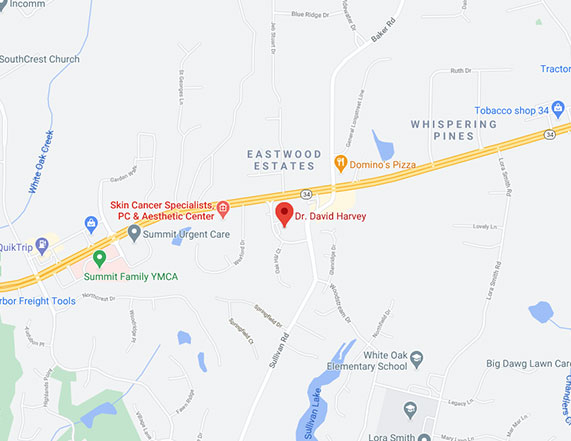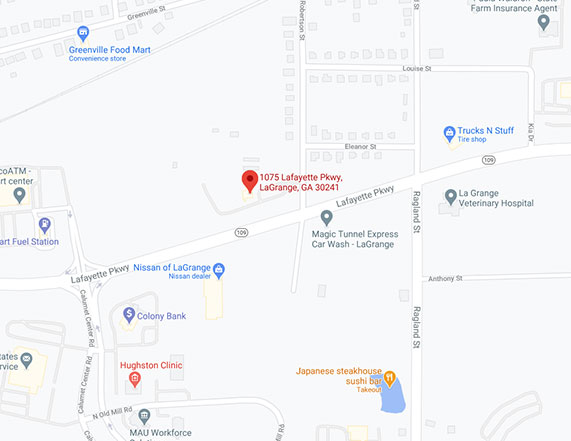Conveniently located to serve Newnan, Peachtree City and LaGrange
Click here to jump to:
Newnan Rosacea
WHAT IS ROSACEA?
Rosacea is a skin disorder which can cause flushing and breakouts of the skin. It usually starts with redness on the cheeks and can slowly worsen.
Because the changes associate with rosacea are gradual, it may be hard to recognize in its early stages. Unfortunately, many people mistake rosacea for a sunburn, a complexion change, or acne and do not contact a physician. Rosacea can’t be cured, but it can be controlled.
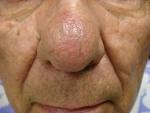
Rosacea (Stage I, III) – Flushing of the nose and cheeks with early rhinophyma.
WHAT SHOULD I LOOK FOR?
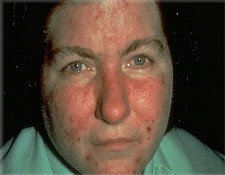
Rosacea (Stage II) – Pimples and redness are seen.
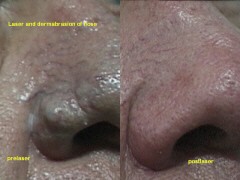
Rosacea – nasal bumps.
Many rosacea patients have only one or two symptoms; here is a complete list of the most common ones:
Redness
This resembles a blush or sunburn and it is caused by flushing (when a larger amount of blood flows through vessels quickly and the vessels dilate to handle the increased flow). Redness can gradually become more noticeable and will not go away. Facial skin may get very dry.
Pimples (Papules)
Later, as the disease progresses, pimples may appear on the face. These pimples may be inflamed — small, red and solid (papules) or pus-filled (pustules) like teenage acne. Because they look alike, rosacea has been called “adult acne” or “acne rosacea.” But, people with rosacea do not normally have the blackhead or whitehead type of pimples (called comedones) that are usually seen in teenagers.
Red lines
When people with rosacea flush, the small blood vessels of the face may get larger — eventually showing through the skin. These enlarged blood vessels resemble thin red lines on the face, usually on the cheeks. These lines may be hidden at first by flushing, blushing or redness, but they usually reappear when the redness is cleared up. They can be treated with a vascular laser.
Stinging
Sometimes patients with rosacea complain of stinging or burning. These symptoms can be treated with oral antibiotics, laser, or photodynamic therapy
Nasal Bumps
In more extreme cases, patients may notice small knobby bumps on the nose. As more bumps appear, the nose becomes more swollen and disfigured. This condition is referred to as rhinophyma.
WHAT CAUSES ROSACEA?
There are many theories but none have been proven. Researchers believe that there is a link between rosacea and how often people blush. There is thought to be a neurovascular mechanism involved. Demodex mites and antibodies to the bacteria H. Pylori have also been implicated.
Related
Content
Patient
Review
“Always happy with Dr. Harvey’s office and services!”
by Anonymous
WHO GETS ROSACEA?
It seems to affect fair-skinned adults more often, though it can affect any skin type. Most who suffer from rosacea have a history of flushing or blushing. Women get rosacea slightly more often than men but men are more likely to develop rhinophyma. The image of one famous sufferer, W. C. Fields, helped to mistakenly link rosacea with alcoholism. Although drinking alcohol can make rosacea worse, people who never drink alcohol can also develop rosacea.
WHAT TREATMENTS ARE USED FOR ROSACEA?
Several medications are available by doctor’s prescription. They control redness and reduce the number of papules and pustules. Some treatments are topically applied to the skin. In most cases, it may take several weeks to see results — don’t worry. Once symptoms have cleared, patients may need to continue using prescription medications to keep their rosacea under control.
CAN ROSACEA BE CURED?
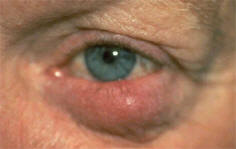
Ocular Stage – Redness and Dryness of the Eyes.
Not yet. But simple treatments can control rosacea, improve the skin’s look and maybe even stop or reverse progress of the disease. Getting help early and following the treatment programs prescribed are the keys to improving the condition
CAN ANYTHING MAKE ROSACEA WORSE?
The most common triggers are: hot drinks, alcohol, spicy foods, stress, sunlight, extreme heat or cold.
Experts say you should avoid anything that causes skin flushing. But what bothers one person may not cause a problem in another. You will need to find out what things affect you and decide if you want to change your habits to avoid them. Just remember — flushing may affect your success in controlling rosacea. Talk to Dr. Harvey about how you can learn to identify — and deal with — your own flushing triggers.
WHAT ABOUT WASHING OR MOISTURIZING MY FACE?
Following a regular cleansing and medication routine will make treatment easier and more successful. You should be careful about what products you use with rosacea medications.
- Soaps/Cleansers — Only very mild products should be used on the face. Avoid products that contain alcohol or irritants.
- Moisturizers — Apply a quality moisturizer as needed. When using with a topical medication, you can usually apply the moisturizer after the medication has dried.
- Sunscreens — Use a broad spectrum sunscreen SPF 30 or higher whenever you think you will be in the sun.
In general, it helps to choose facial products that will not clog pores; they will have the word “noncomedogenic” on the package. Avoid products that contain alcohol (check hair spray and astringent labels), acetone or oil.
For more information on rosacea or to set up an appointment, click here. Thank you and we look forward to helping you.
National Rosacea Organization – The popular website for those who are afflicted with rosacea. Learn about the signs and symptoms of rosacea. Free educational materials and a periodic newsletter, Rosacea Review, are also available. http://www.rosacea.org.










